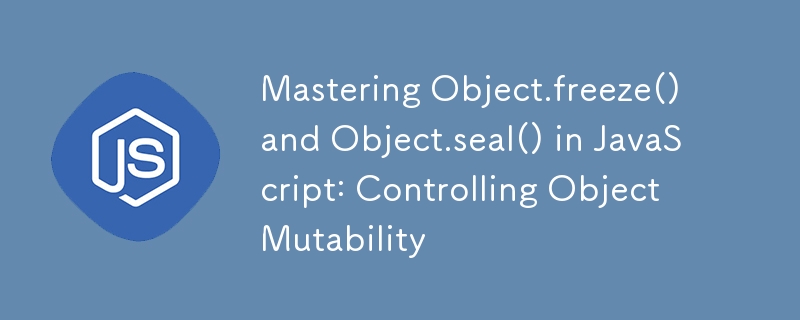
Object.freeze and Object.seal in JavaScript
When working with objects in JavaScript, controlling their mutability is essential to prevent unintended changes. Two methods provided by JavaScript for this purpose are Object.freeze() and Object.seal(). Understanding their differences and use cases is key to writing robust code.
1. Object.freeze()
The Object.freeze() method makes an object immutable. This means:
- No new properties can be added.
- Existing properties cannot be modified, removed, or reconfigured.
- The object is effectively "frozen" and cannot be changed in any way.
Syntax:
Object.freeze(obj);
Copy after login
Copy after login
Example:
const obj = { name: "Alice", age: 25 };
Object.freeze(obj);
obj.age = 30; // Does nothing (strict mode: throws an error)
obj.gender = "female"; // Does nothing (strict mode: throws an error)
delete obj.name; // Does nothing (strict mode: throws an error)
console.log(obj); // { name: "Alice", age: 25 }
Copy after login
Copy after login
Use Case:
- To ensure that an object remains constant throughout your program, such as configuration settings.
Checking if an Object is Frozen:
Use Object.isFrozen() to determine if an object is frozen:
console.log(Object.isFrozen(obj)); // true
Copy after login
Copy after login
2. Object.seal()
The Object.seal() method restricts modifications to an object but is less strict than Object.freeze(). It allows:
-
Modification of existing properties (values can change).
-
Prevention of adding or removing properties.
Syntax:
Object.seal(obj);
Copy after login
Example:
const obj = { name: "Bob", age: 30 };
Object.seal(obj);
obj.age = 35; // Allowed: Existing properties can be modified
obj.gender = "male"; // Does nothing (strict mode: throws an error)
delete obj.name; // Does nothing (strict mode: throws an error)
console.log(obj); // { name: "Bob", age: 35 }
Copy after login
Use Case:
- When you want to protect the structure of an object (prevent additions/deletions) but still allow changes to property values.
Checking if an Object is Sealed:
Use Object.isSealed() to determine if an object is sealed:
Object.freeze(obj);
Copy after login
Copy after login
3. Key Differences Between Object.freeze() and Object.seal()
| Feature |
Object.freeze() |
Object.seal() |
| Add new properties |
| Feature |
Object.freeze() |
Object.seal() |
| Add new properties |
Not allowed |
Not allowed |
| Remove existing properties |
Not allowed |
Not allowed |
| Modify existing properties |
Not allowed |
Allowed |
| Reconfigure property descriptors |
Not allowed |
Not allowed |
| Use case |
Immutable objects (constants) |
Restrict structure but allow value changes |
Not allowed |
Not allowed
|
| Remove existing properties |
Not allowed |
Not allowed
|
| Modify existing properties |
Not allowed |
Allowed
|
| Reconfigure property descriptors |
Not allowed |
Not allowedconst obj = { name: "Alice", age: 25 };
Object.freeze(obj);
obj.age = 30; // Does nothing (strict mode: throws an error)
obj.gender = "female"; // Does nothing (strict mode: throws an error)
delete obj.name; // Does nothing (strict mode: throws an error)
console.log(obj); // { name: "Alice", age: 25 }
Copy after login Copy after login |
| Use case |
Immutable objects (constants) |
Restrict structure but allow value changes |
4. Frozen and Sealed Nested Objects
console.log(Object.isFrozen(obj)); // true
Copy after login
Copy after login
Both Object.freeze() and Object.seal() are shallow, meaning they do not affect nested objects. To deeply freeze or seal an object, you need to recursively apply the method to each nested object.
- Example (Shallow Effect):
-
Deep Freeze Helper Function:
-
5. Common Pitfalls and Tips
Non-strict Mode Behavior
: In non-strict mode, changes to frozen or sealed objects fail silently. Always use strict mode ("use strict";) for clearer debugging.
Prevent Confusion with Object Mutability: Clearly document when and why an object is frozen or sealed to avoid misinterpretations in team environments.
Seal Before Freezing
: If you want both restricted structure and immutability, seal the object first, then freeze it.
Conclusion
Both Object.freeze() and Object.seal() are valuable tools for managing object immutability in JavaScript. While Object.freeze() ensures complete immutability, Object.seal() offers flexibility by allowing changes to existing property values. Choosing the right method depends on the level of control you need over your objects.
Hi, I'm Abhay Singh Kathayat!
I am a full-stack developer with expertise in both front-end and back-end technologies. I work with a variety of programming languages and frameworks to build efficient, scalable, and user-friendly applications.
Feel free to reach out to me at my business email: kaashshorts28@gmail.com.
The above is the detailed content of Mastering Object.freeze() and Object.seal() in JavaScript: Controlling Object Mutability. For more information, please follow other related articles on the PHP Chinese website!






